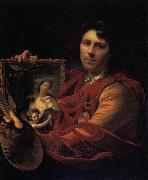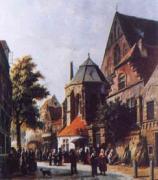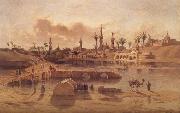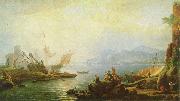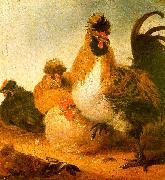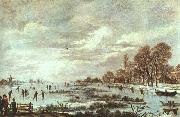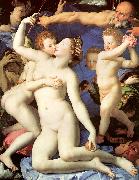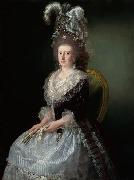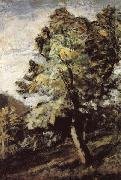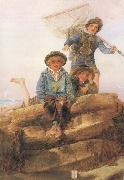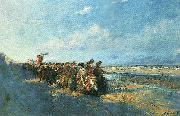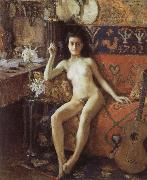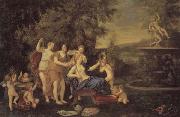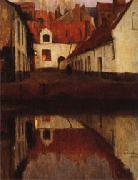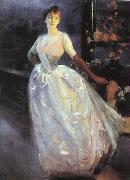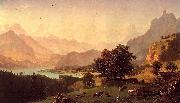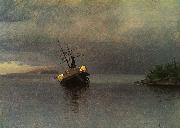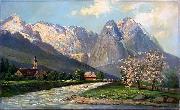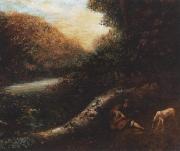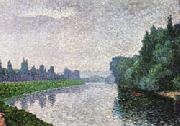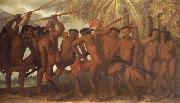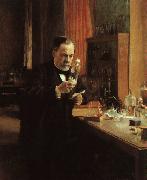|
|
|
|
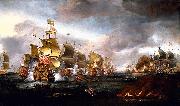 |
Adriaen Van Diest
|
|
was born at the Hague in 1655. He was the son of Jeronymus van Diest, a painter of sea-pieces, by whom he was instructed in the art. When he was seventeen years of age he came to London, and was employed by Granville, Earl of Bath, for whom he painted several views and ruins in the west of England. He also painted portraits, but did not meet with much encouragement, although his pictures, particularly his landscapes, possess considerable merit; as a proof of which Horace Walpole states that there were seven pictures by Van Diest in Sir Peter Lely's collection. He etched several landscapes from his own designs, in a slight, masterly style. Van Diest died in London in 1704. Unfortunately for his reputation, he is generally known by his worst pictures, which are frequently found in old houses, on wainscots, or over doors, and are executed in a hasty manner, with much mountainous background. His better pictures have changed their name.
|
|
|
|
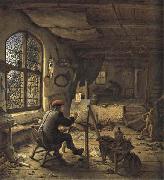 |
adriaen van ostade
|
|
Adriaen van Ostade (baptized as Adriaen Hendricx December 10, 1610 ?C buried May 2, 1685) was a Dutch genre painter.
He was the eldest son of Jan Hendricx Ostade, a weaver from the town of Ostade near Eindhoven. Although Adriaen and his brother Isaack were born in Haarlem, they adopted the name "van Ostade" as painters.
"Peasants in a Tavern" (c. 1635), at the Alte Pinakothek, MunichAccording to Jacobus Houbraken, he was taught from 1627 by Frans Hals, at that time the master of Adriaen Brouwer and Jan Miense Molenaer. At twenty-six he joined a company of the civic guard at Haarlem, and at twenty-eight he married. His wife died in 1640, and he speedily re-married. He again became a widower in 1666. In 1662 he took the highest honors of his profession with the presidency of the painters Guild of Saint Luke in Haarlem. Among the treasures of the Louvre is a striking picture of a father sitting in state, his wife at his side, surrounded by his son, five daughters, and a young married couple in a handsomely furnished room. By an old tradition, Ostade here painted himself and his children in holiday attire; but the style is much too refined for the painter of boors, and Ostade had but one daughter. |
|
|
|
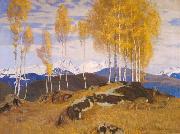 |
Adrian Scott Stokes
|
|
RA (1854-1935) was an English landscape painter. Born in Southport, Lancashire, he became a cotton broker in Liverpool, where his artistic talent was noticed by John Herbert RA, who advised him to submit his drawings to the Royal Academy. He entered the Royal Academy Schools in 1872 and exhibited at the Academy from 1876. In that year went to France where he lived for 10 years, settling back in England in 1886, at Carbis Bay and joining the artists' colony at St Ives.
Adrian Stokes was a landscape painter, concerned most with atmospheric effects, and later with decorative landscapes. He was the author of 'Landscape Painting' (1925). He became ARA in 1909 and RA in 1919, won medals at the Paris Exhibition and Chicago World Fair (1889), became first President of the St Ives Society of Arts (1890) and Vice President of the Royal Watercolour Society (1932).
He married Marianne Preindlesberger of Graz, Austria, in 1884, while living in France. She became a well known artist under her married name of Marianne Stokes. An obituary of Adrian Stokes was published in The Times Monday 2 December 1935
|
|
 |
Adrian Vanson
|
|
Adrian Vanson (died c. 1602) was court portrait painter to James VI of Scotland.
Adrian succeeded Arnold Bronckorst as court painter in Scotland in May 1584, and his appointment was subsequently confirmed by royal letter on 20 August 1584. Adrian Vanson was paid £8-10s in June 1581 for two pictures sent to Theodore Beza. A letter by James VI's former tutor Peter Young accompanied pictures of John Knox and George Buchanan sent to Geneva in November 1579 for the woodcuts in Beza's Icones (1580). The Scottish portraits arrived too late for the book, and the woodcuts of Knox and a James VI, thought to be by Vanson, were first published in Simon Goulart's edition of the Icones in 1581. The picture of George Buchanan, which was never published in Beza's Icones, but may have appeared in other later works, is attributed to Bronckorst.
Knox from Beza's Icones,
after Adrian VansonVanson also painted ceremonial spears and banners for the coronation of Anne of Denmark. When he was made a burgess of Edinburgh, it was hoped he would teach his craft to apprentices. He may have been 'Lord Seton's painter', who was recorded drawing portraits for coins at the mint in Edinburgh. There was a un-named Flemish painter working on the king's portrait at Stirling Castle in May 1579. This may have been Vanson or Bronckorst. According to the inventories of the Earl of Leicester, he had a portrait of the 'young king of Scots' in 1580, which may have been another copy of this picture. Leicester sent his own portrait to James VI, painted on canvas by Hubbard in 1583.
Attributed portraits include James VI; Anne of Denmark; Patrick Lyon, Lord Glamis; Sir Thomas Kennedy of Culzean; Agnes Douglas, Countess of Argyll. Vanson's James VI of circa 1585 survives at Edinburgh castle. In May 1586 a French ambassador in Scotland, the Baron d'Esneval, promised to get Mary, Queen of Scots a copy of a recent portrait of James VI from the only painter in Edinburgh. There had been rumours of an embassy to Denmark to discuss the king's marriage in April 1586. It is thought the picture at Edinburgh Castle was made by Vanson for this embassy or a similar purpose. |
|
|
|
|
|
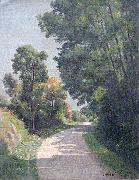 |
Adrien Lavieille
|
|
(March 29, 1848, Montmartre - February 5, 1920, Chartres) was a French painter.
Portrait of Adrien Lavieille in 1879, by his wife, Marie Adrien Lavieille.
Oil on canvas (private collection).Son of the landscape painter Eugene Lavieille, and nephew of the wood engraver Jacques Adrien Lavieille, he was a painter of the country : near Paris, in Brittany, near Cancale and on the riverside of the Vilaine in the south of Rennes, in Touraine, at Saint-Jean-de-Monts in Vendee, where he was invited by a friend, the painter and engraver Auguste Lepere, around Vendôme where he sojourned in the home of his daughter, Andree Lavieille, so a painter, and of his son-in-law, the man of letters, Paul Tuffrau.
He also painted in Montmartre, where he lived during his youthful days, and, as his father, at Moret-sur-Loing, near Fontainebleau.
Parallelly to his painter's activities, Adrien Lavieille executed, during his life, for money's reasons, works of restoration and decoration : basilica Saint-Martin in Tours (where he worked with the painter Pierre Fritel), Palais de Justice of Rennes, Château de Vaux-le-Vicomte, Hôtel de Lauzun, quai d'Anjou in Paris.
In 1878, he married the painter Marie Petit. |
|
|
|
|
|
 |
Aelbrecht Bouts
|
|
( 1450s, Leuven - March 1549, Leuven) was a Netherlandish painter. His first name is sometimes spelled eAlberte, eAelberte or eAlbrechte. He was born into a family of painters. Aelbrechtes father was Dieric Bouts the Elder (ca.1415-1475), and his brother was Dieric Bouts the Younger (ca.1448-1490). Jan Bouts (ca.1478-ca. 1530), son of Dieric Bouts the Younger, also became a painter. Dieric Bouts the Younger inherited his fatheres shop in 1475, while Aelbrecht established his own workshop, also in Leuven. Whereas Dieric the Younger continued in his father's style, Aelbrecht developed his own unmistakable style with strong colors, rich texture and fine details.
Bob Jones University Museum and Gallery (Greenville, South Carolina), the Cleveland Museum of Art, the Fitzwilliam Museum (Cambridge), Harvard University Art Museums, The Honolulu Academy of Arts, the Hood Museum of Art (Hanover, New Hampshire), the Norton Simon Museum (Pasadena, California), the Royal Museums of Fine Arts of Belgium, the Czartoryski Museum and the Staatsgalerie Stuttgart are among the public collections having paintings by Aelbrecht Bouts.
|
|
 |
Aelst, Willem van
|
|
Dutch Baroque Era Painter, 1627-ca.1683
Studied under Otto Marseus van Schrieck.
Students included Rachel Ruysch.
Specializes in Still Life.
|
|
|
|
|
|
|
|
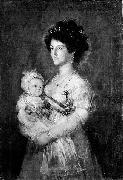 |
After Francisco de Goya
|
|
Francisco Jose de Goya y Lucientes (30 March 1746 - 16 April 1828) was a Spanish romantic painter and printmaker regarded both as the last of the Old Masters and the first of the moderns. Goya was a court painter to the Spanish Crown, and through his works was both a commentator on and chronicler of his era. The subversive and imaginative element in his art, as well as his bold handling of paint, provided a model for the work of later generations of artists, notably Manet, Picasso and Francis Bacon.
|
|
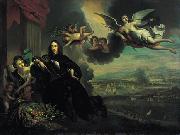 |
After Jan de Baen
|
|
Jan de Baen (20 February 1633 - 1702) was a Dutch portrait painter who lived during the Dutch Golden Age. He was a pupil of the painter Jacob Adriaensz Backer in Amsterdam from 1645 to 1648. He worked for Charles II of England in his Dutch exile, and from 1660 until his death he lived and worked in The Hague. His portraits were popular in his day, and he painted the most distinguished people of his time. |
|
 |
After Peter Paul Rubens
|
|
Sir Peter Paul Rubens (Dutch pronunciation: [ˈrybə(n)s]; 28 June 1577 - 30 May 1640), was a Flemish Baroque painter, and a proponent of an extravagant Baroque style that emphasised movement, colour, and sensuality. He is well-known for his Counter-Reformation altarpieces, portraits, landscapes, and history paintings of mythological and allegorical subjects.
In addition to running a large studio in Antwerp that produced paintings popular with nobility and art collectors throughout Europe, Rubens was a classically educated humanist scholar, art collector, and diplomat who was knighted by both Philip IV, King of Spain, and Charles I, King of England.
|
|
|
|
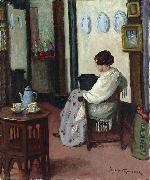 |
Agnes Goodsir
|
|
(18 June 1864, Portland, Victoria - 1939, France) was an Australian portrait painter who moved within lesbian circles in Paris in the 1920s and 1930s.
Goodsir was one of eleven children born to David James Cook Goodsir, Commissioner of Customs at Melbourne, and Elizabeth Archer.
Her early art training started with Arthur T. Woodward at the Bendigo School of Mines in the 1890s, and in 1899 some of her work was raffled in Bendigo to partly finance her study in Paris. The years following World War I saw a virtual exodus of Australian artists on a sort of Grand Tour to Paris, all intent on being part of the explosion of the arts taking place there. Painters like Rupert Bunny, Stella Bowen and Max Meldrum were drawn there by the appeal of the Left Bank. Others like Margaret Preston and Grace Crowley were inspired to develop in new directions by post-war Parisian art.
Goodsir attended the Academie Delecluse, the Academie Julian and then the Academie Colarossi. From about 1912 she shuttled between London and Paris, but finally settled in Paris at 18 Rue de l'Odeon. Her constant companion was Rachel Dunn, depicted in several of her paintings, such as The Chinese Skirt 1933, Girl with Cigarette 1925, The Letter 1926 and Morning Tea 1925.
Her work was acclaimed and exhibited at the New Salon, the Salon des Independants, and the Societe Nationale des Beaux Arts in Paris as well as at the Royal Academy and the Royal Institute in London. On a short visit to Australia in 1927 she exhibited at the Macquarie Galleries in Sydney and the Fine Arts Gallery in Melbourne. In 1938 four of her oils were shown at the sesquicentennial exhibition at the NSW National Art Gallery.
On her death in 1939, her paintings were left to her companion Rachel Dunn, who sent some 40 to Agnes's family in Australia and others to Australian galleries. |
|
 |
Agnolo Gaddi
|
|
Italian Early Renaissance Painter, ca.1345-1396 |
|
|
|
 |
Agnolo Gaddi
|
|
Italian Early Renaissance Painter, ca.1345-1396 |
|
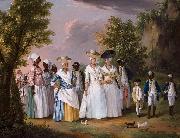 |
Agostino Brunias
|
|
Agostino Brunias (c. 1730 - April 2, 1796) was a London-based Italian painter from Rome. Strongly associated with West Indian art, he left England at the height of his career to chronicle Dominica and the neighboring islands of the West Indies. Painted in the tradition of verite ethnographique, his art was as escapist as it was romantic.
Brunias was born in Rome c. 1730; the exact date is uncertain. His first name has been spelled in various ways including Abraham, Alexander, August, or Austin, while his surname has been recorded as Brunais and Brunyas. Brunias was a student at the Accademia di San Luca, Rome, where he won Third Prize in the Second Class for painting in 1754. An early oil painting of his was exhibited in Rome two years earlier. |
|
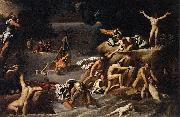 |
Agostino Carracci
|
|
(16 August 1557 - 22 March 1602) was an Italian painter and printmaker. He was the brother of the more famous Annibale and cousin of Lodovico Carracci.
He posited the ideal in nature, and was the founder of the competing school to the more gritty (for lack of a better term) view of nature as expressed by Caravaggio. He was one of the founders of the Accademia degli Incamminati along with his brother, Annibale Carracci, and cousin, Ludovico Carracci. The academy helped propel painters of the School of Bologna to prominence.
Agostino Carracci was born in Bologna, and trained at the workshop of the architect Domenico Tibaldi. Starting from 1574 he worked as a reproductive engraver, copying works of 16th century masters such as Federico Barocci, Tintoretto, Antonio Campi, Veronese and Correggio. He also produced some original prints, including two etchings.
He travelled to Venice (1582, 1587 - 1589) and Parma (1586 - 1587). Together with Annibale and Ludovico he worked in Bologna on the fresco cycles in Palazzo Fava (Histories of Jason and Medea, 1584) and Palazzo Magnani (Histories of Romulus, 1590 - 1592). In 1592 he also painted the Communion of St. Jerome, now in the Pinacoteca di Bologna and considered his masterwork. From 1586 is his altarpiece of the Madonna with Child and Saints, in the National Gallery of Parma.
In 1598 Carracci joined his brother Annibale in Rome, to collaborate on the decoration of the Gallery in Palazzo Farnese. From 1598 - 1600 is a triple Portrait, now in Naples, an example of genre painting.
In 1600 he was called to Parma by Duke Ranuccio I Farnese to began the decoration of the Palazzo del Giardino, but he died before it was finished.
Agostino's son Antonio Carracci was also a painter, and attempted to compete with his father's Academy.
|
|
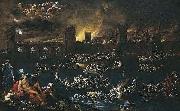 |
Agostino Tassi
|
|
(1578--1644) was an Italian painter, mostly of landscapes and seascapes.
Because he aspired to nobility he modified the details of his early life. Though he was born in Perugia he claimed to have been born in Rome. His family name was Buonamici, but Agostino adopted the surname Tassi to give substance to his story that he was adopted by the Marchese Tassi. He was actually the son of a furrier named Domenico. |
|
|
|
|
|
|
|
|
|
|
|
|
|
|
|
|
|
 |
Albani, Francesco
|
|
Italian Baroque Era Painter, 1578-1660
Albani's students included Pier Francesco Mola and Andrea Sacchi |
|
|
|
|
|
|
|
|
|
|
|
|
|
|
|
|
|
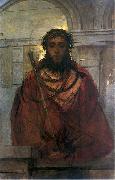 |
Albert Chmielowski
|
|
(born Adam Hilary Bernard Chmielowski; 1845 - 1916) was a Polish religious brother and founder of the Albertines. He is a saint of the Catholic Church. Albert is also known as Brat Albert (Brother Albert); in recognition of his holiness, he has also been called the "Brother of Our Lord", "Brother of Our God", and "Our God's Brother".
Adam Chmielowski was born to a wealthy aristocratic family, and initially studied agriculture with the intention of managing the family estate. Involved in politics since his youth, he lost a leg at the age of 17 while fighting in an insurrection. He became a well-known and well-liked artist in Krakew, his political convictions inspiring his interest in the human condition. A gentle and compassionate spirit, Chmielowski felt compelled to help those in need and after years of reflection, decided to follow his calling into the service of God.
In 1880, Chmielowski joined the Jesuits, took up the name Albert and abandoned painting. He began a life of service to the poor. In 1887, he founded the Brothers of the Third Order of Saint Francis, Servants of the Poor, known in honor of their founder as the Albertines or the Gray Brothers, after their rough gray habits. In 1891, he founded the women's congregation, the Gray Sisters. The Albertines organized food and shelter for the poor and homeless.
Albert believed that the great calamity of our time is that so many refuse to see and relieve the suffering of others. The so-called "haves" live away from the "have-nots", ignoring them and leaving their care to society.
|
|
|
|
|
|
|
|
|
|
|







